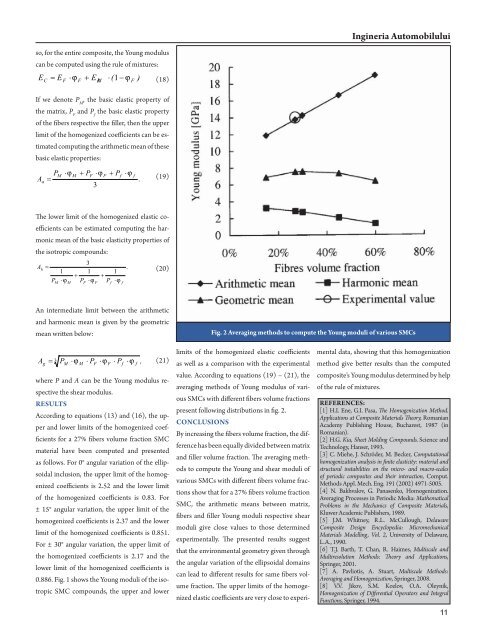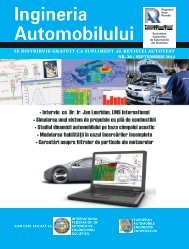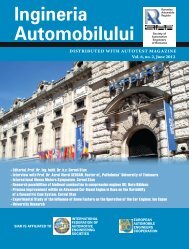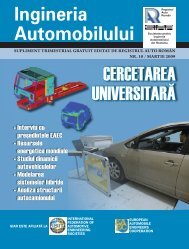DACIA ELECTRA - ingineria-automobilului.ro
DACIA ELECTRA - ingineria-automobilului.ro
DACIA ELECTRA - ingineria-automobilului.ro
Create successful ePaper yourself
Turn your PDF publications into a flip-book with our unique Google optimized e-Paper software.
so, for the entire composite, the Young modulus<br />
can be computed using the rule of mixtures:<br />
= E ⋅ϕ<br />
+ E ⋅(<br />
1 − ϕ ). (18)<br />
EC F F RM<br />
F<br />
If we denote P , the basic elastic p<strong>ro</strong>perty of<br />
M<br />
the matrix, P and P the basic elastic p<strong>ro</strong>perty<br />
F f<br />
of the fi bers respective the fi ller, then the upper<br />
limit of the homogenized coeffi cients can be estimated<br />
computing the arithmetic mean of these<br />
basic elastic p<strong>ro</strong>perties:<br />
PM<br />
⋅ϕ<br />
M + PF<br />
⋅ϕ<br />
F + Pf<br />
⋅ϕ<br />
f<br />
Aa<br />
=<br />
.<br />
3<br />
(19)<br />
Th e lower limit of the homogenized elastic coeffi<br />
cients can be estimated computing the harmonic<br />
mean of the basic elasticity p<strong>ro</strong>perties of<br />
the isot<strong>ro</strong>pic compounds:<br />
3<br />
Ah<br />
=<br />
.<br />
1 1 1<br />
+ +<br />
P ⋅ϕ<br />
P ⋅ϕ<br />
P ⋅ϕ<br />
M<br />
M<br />
F<br />
F<br />
f<br />
f<br />
(20)<br />
An intermediate limit between the arithmetic<br />
and harmonic mean is given by the geometric<br />
mean writt en below:<br />
Ag = 3 PM<br />
⋅ϕ<br />
M ⋅ PF<br />
⋅ϕ<br />
F ⋅ Pf<br />
⋅ϕ<br />
f ,<br />
(21)<br />
where P and A can be the Young modulus respective<br />
the shear modulus.<br />
RESULTS<br />
According to equations (13) and (16), the upper<br />
and lower limits of the homogenized coeffi<br />
cients for a 27% fi bers volume fraction SMC<br />
material have been computed and presented<br />
as follows. For 0° angular variation of the ellipsoidal<br />
inclusion, the upper limit of the homogenized<br />
coeffi cients is 2.52 and the lower limit<br />
of the homogenized coeffi cients is 0.83. For<br />
± 15° angular variation, the upper limit of the<br />
homogenized coeffi cients is 2.37 and the lower<br />
limit of the homogenized coeffi cients is 0.851.<br />
For ± 30° angular variation, the upper limit of<br />
the homogenized coeffi cients is 2.17 and the<br />
lower limit of the homogenized coeffi cients is<br />
0.886. Fig. 1 shows the Young moduli of the isot<strong>ro</strong>pic<br />
SMC compounds, the upper and lower<br />
limits of the homogenized elastic coeffi cients<br />
as well as a comparison with the experimental<br />
value. According to equations (19) – (21), the<br />
averaging methods of Young modulus of various<br />
SMCs with diff erent fi bers volume fractions<br />
present following distributions in fi g. 2.<br />
CONCLUSIONS<br />
By increasing the fi bers volume fraction, the difference<br />
has been equally divided between matrix<br />
and fi ller volume fraction. Th e averaging methods<br />
to compute the Young and shear moduli of<br />
various SMCs with diff erent fi bers volume fractions<br />
show that for a 27% fi bers volume fraction<br />
SMC, the arithmetic means between matrix,<br />
fi bers and fi ller Young moduli respective shear<br />
moduli give close values to those determined<br />
experimentally. Th e presented results suggest<br />
that the envi<strong>ro</strong>nmental geometry given th<strong>ro</strong>ugh<br />
the angular variation of the ellipsoidal domains<br />
can lead to diff erent results for same fi bers volume<br />
fraction. Th e upper limits of the homogenized<br />
elastic coeffi cients are very close to experi-<br />
Ingineria Automobilului<br />
Fig. 2 Averaging methods to compute the Young moduli of various SMCs<br />
mental data, showing that this homogenization<br />
method give bett er results than the computed<br />
composite’s Young modulus determined by help<br />
of the rule of mixtures.<br />
REFERENCES:<br />
[1] H.I. Ene, G.I. Pasa, Th e Homogenization Method.<br />
Applications at Composite Materials Th eory, Romanian<br />
Academy Publishing House, Bucharest, 1987 (in<br />
Romanian).<br />
[2] H.G. Science and<br />
Technology, Hanser, 1993.<br />
[3] C. Miehe, J. Schröder, M. Becker, Computational<br />
homogenization analysis in fi nite elasticity: material and<br />
structural instabilities on the mic<strong>ro</strong>- and mac<strong>ro</strong>-scales<br />
of periodic composites and their interaction, Comput.<br />
Methods Appl. Mech. Eng. 191 (2002) 4971-5005.<br />
[4] N. Bakhvalov, G. Panasenko, Homogenization.<br />
Averaging P<strong>ro</strong>cesses in Periodic Media: Mathematical<br />
P<strong>ro</strong>blems in the Mechanics of Composite Materials,<br />
Kluwer Academic Publishers, 1989.<br />
[5] J.M. Whitney, R.L. McCullough, Delaware<br />
Composite Design Encyclopedia: Mic<strong>ro</strong>mechanical<br />
Materials Modelling, Vol. 2, University of Delaware,<br />
L.A., 1990.<br />
[6] T.J. Barth, T. Chan, R. Haimes, Multiscale and<br />
Multiresolution Methods: Th eory and Applications,<br />
Springer, 2001.<br />
[7] A. Pavliotis, A. Stuart, Multiscale Methods:<br />
Averaging and Homogenization, Springer, 2008.<br />
[8] V.V. Jikov, S.M. Kozlov, O.A. Oleynik,<br />
Homogenization of Diff erential Operators and Integral<br />
Functions, Springer, 1994.<br />
11















